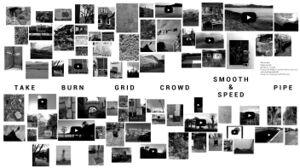Representation: Difference between revisions
(Created page with "==representation↵== Feral Atlas ''Feral Atlas'' sometimes uses the term ‘stories’ to refer to how we tell things and so form knowledge. Our use of the term is to open up a discussion of genre. What kind of storytelling is most appropriate for the Anthropocene? ''Feral Atlas'' is designed as an exploratory and open journey through an assembled polyphony of materials. Hand-painted watercolours, hydrophone recordings, molecular diagrams, scientific charts, sketches...") |
Tag: Manual revert |
||
| (20 intermediate revisions by 4 users not shown) | |||
| Line 1: | Line 1: | ||
== | ==representation== | ||
<span class="author">Feral Atlas (Lili Carr & Feifei Zhou)</span> | |||
Feral Atlas | <div class="no-indent">''Feral Atlas'' sometimes uses the term ‘stories’ to refer to how we tell things and so form knowledge. Our use of the term is to open up a discussion of genre. What kind of storytelling is most appropriate for the Anthropocene?</div> | ||
''Feral Atlas'' | ''Feral Atlas'' is designed as an exploratory and open journey through an assembled polyphony of materials. Hand-painted watercolours, hydrophone recordings, molecular diagrams, scientific charts, sketches, sound art, and maps made from satellite data and calculated projections sit alongside scientific writing, autoethnography, memoir, poetry, biological modelling, music, video poems, and song. Each element provides an account of the Anthropocene in its own right. Yet when they come together, these diverse elements perform an iterative, multisensuous, and multiperspectival account of how imperial and industrial infrastructures make Anthropocene worlds. | ||
''Feral Atlas'' is | ''Feral Atlas'' tries to forge an aesthetic that asks readers to linger over the gathered materials; to tell stories so beautifully that people stop to pay attention to what is going on, and to hold their attention to the scenes of action in which <mark class="c7">feral</mark> ecologies play out. Presenting materials with such absorbing detail, passion, and care that readers might become curious to know more, and in doing so become attuned, able to navigate and orientate themselves within a multidisciplinary array of representational modes. | ||
<span class="page-break"> </span> | |||
During the symposium Making Matters: Collective Material Practices in Critical Times, we (Feral Atlas members Feifei Zhou and Lili Carr) conducted a | <div class="referencing">During the symposium Making Matters: Collective Material Practices in Critical Times, we (Feral Atlas members Feifei Zhou and Lili Carr) conducted a <mark class="c4">workshop</mark> in noticing <mark class="c7">feral</mark> effects in the area where you live. A screenshot of our collective online map of collated observations is reproduced overleaf. | ||
[ | ''Feral Atlas'' is curated and edited by Anna L. Tsing, Jennifer Deger, Alder Keleman Saxena and Feifei Zhou. It can be accessed online at Stanford University Press: [http://www.feralatlas.org www.feralatlas.org.]</div> | ||
A collective work by the participants of ''Feral Atlas as a Verb'' | <span class="spread">[[File:Representation - Feral Atlas.jpg|thumb|A collective work by the participants of ''Feral Atlas as a Verb'' at Making Matters Symposium: Collective Material Practices in Critical Times (Het Nieuwe Instituut Rotterdam, 21 Nov 2020) and at Driving the Human Opening Festival (ZKM Karlsruhe, 22 Nov 2020).]]</span> | ||
Latest revision as of 11:05, 12 April 2022
representation
Feral Atlas is designed as an exploratory and open journey through an assembled polyphony of materials. Hand-painted watercolours, hydrophone recordings, molecular diagrams, scientific charts, sketches, sound art, and maps made from satellite data and calculated projections sit alongside scientific writing, autoethnography, memoir, poetry, biological modelling, music, video poems, and song. Each element provides an account of the Anthropocene in its own right. Yet when they come together, these diverse elements perform an iterative, multisensuous, and multiperspectival account of how imperial and industrial infrastructures make Anthropocene worlds.
Feral Atlas tries to forge an aesthetic that asks readers to linger over the gathered materials; to tell stories so beautifully that people stop to pay attention to what is going on, and to hold their attention to the scenes of action in which feral ecologies play out. Presenting materials with such absorbing detail, passion, and care that readers might become curious to know more, and in doing so become attuned, able to navigate and orientate themselves within a multidisciplinary array of representational modes.
